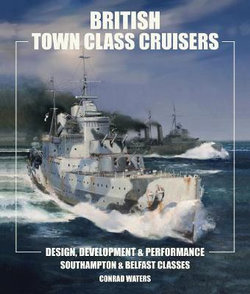
British Town Class Cruisers. Design, Development and Performance. Southampton and Belfast Classes. By Conrad Waters. Seaforth Publishing, Barnsley, 2019.
Reviewed by David Hobbs
Conrad Waters will be best known to ANI members as the editor of Seaforth’s very successful annual World Naval Review since its first edition in 2010. His book on the Royal Navy’s Town class cruisers is clearly the result of many years of painstaking and dedicated research and the author’s deep interest in the subject is apparent on every page.
It is extensively illustrated with beautifully reproduced photographs and drawings which are arguably worth the recommended retail price in their own right but it is the text that makes this book stand out. The first chapter describes the RN requirement for trade-protection cruisers in the years after 1918 and it includes the Amphion class that became HMA Ships Perth, Sydney and Hobart. It explains that the Town class actually evolved from the ‘M’ class sketch design which was effectively an enhanced Amphion with triple, rather than twin, 6-inch guns and a slightly larger hull to accommodate them. Resemblance between the drawings of the original ‘M’ sketch and the 3 Australian cruisers is quite apparent when they are studied. The Town class was intended to counter potentially hostile foreign cruiser designs such as the Japanese Mogami class, hence the need for the heavier main armament. As built, the Towns had raked funnels and masts which, together with the bulky aircraft hangars between the fore-funnel and bridge structure, gave them a very different appearance.
The book is divided into chapters which cover the design origins, construction, pre-war service, wartime improvements, operations, losses in action and fighting performance of these ships. Post-war improvements and service are covered together with the eventual disposals of all but Belfast which became a museum ship on the River Thames in London after 1971. She is still there in 2019. In addition to the remarkable collection of black and white photographs, there are coloured reproductions of ship’s drawings from the National Maritime Museum’s collection in a gate-fold section which opens out to 90 cm, detailed black and white line drawings and coloured drawings of the various paint schemes in which the ships appeared during the Second World War. The latter are the result of considerable research and must represent the latest scholarship on the subject.
Although none of these ships served in the RAN, they did serve alongside Australian ships in the Mediterranean and Pacific theatres during and after the Second World War and many Australians will remember their extensive use during the Korean War. They were designed to protect the British Empire’s trade routes throughout the world and there is much in this study of their evolution that will appeal to all naval professionals, especially the carefully-considered comparison between the design aims of the class, their construction and performance under war conditions that tested all of them to their limit and, for some of them, beyond it. Conrad Waters covers what is a largely technical subject with a very readable style which contains human details with which all sailors will be able to relate. I was fascinated by the description of HMS Edinburgh’s loss off North Russia in May 1942 which quotes several entries from the survivors’ damage report. One stated that the ship was carrying 465 gold ingots, worth £1.5 million at the time, which were being shipped from the Soviet Union as part payment for US war material (all but 5 of these were subsequently recovered by diving expeditions in 1981 and 1986). However the same report is quoted as stating that ‘…much to the chagrin of the victualling staff, the ship sank with 160 sausage rolls on board’. To those who have never spent hours at action stations in an Arctic convoy this may seem frivolous but, as the author points out, the difficulties in providing the ships’ company with hot food and drink from a damaged galley required significant ingenuity in sub-zero temperatures and the rolls would have been valuable and eagerly anticipated in these circumstances as they did not require plates or cutlery and those that were not used immediately could be re-heated. Their loss in such circumstances would certainly have been considered a blow to morale worthy of mention.
The book is an excellent study of how the original staff requirement produced ships that proved capable of accepting the weight and volume of additional new equipment including radar, close-range armament and action-information centres that were unknown at the time it was written. HMS Sheffield, for instance, was the first ship in the RN to be fitted with radar. They were also adapted post-war to feature improved accommodation and those that survived saw a total of two decades of service in an era that saw unprecedented levels of change in the size, composition and deployment of the RN. This book is the best case-study of a specific design that I have read, setting a high standard which must be considered the bench mark against which future descriptions of warship types should be judged. I have no hesitation in recommending it to a wide readership.



